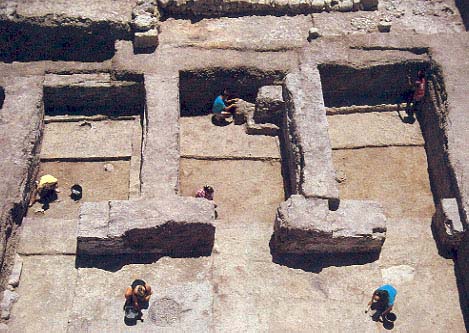Image Details

Ilan Sztulman/Tel Miqne-Ekron Excavation Project
At lower left in the photo, a student volunteer cleans next to a round, pebble-surfaced hearth. Two, and possibly three, pillar bases were found in the main hall (the drawing shows three), similar to the pillar supports in the Philistine temple at Tell Qasile and perhaps akin to the pillars toppled, according to the Book of Judges, by Samson.
The southernmost of the three small rooms (upper right in the photo) contained a small bamah (offering platform). The bamah cannot be seen in the photo, but in the drawing it is shown as a detail at upper right, with the mysterious iron ingot lying on top of it as it was found. The middle room has a white plastered, mudbrick bamah, preserved to a height of 3 feet, on which were found two bowls and a flask with red concentric circles. A bench butts against the base of the bamah on two sides. The northern room, at left in the photo, contains three superimposed floors. A plastered, funnel-shaped installation—presumed to have had some cultic function—was built into the uppermost floor. The opening of the funnel can be seen as a round depression in the rear of the northern room, on the higher floor behind the volunteer. Stacked on the middle floor alongside the wall—possibly on a bench—was a collection of unusual vessels, depicted at lower left in the drawing.
Canaanite tradition favored bamot (pl. of bamah) in free-standing shrines, while the practice in Aegean locales was to build bamot as part of a larger building complex—further indication that the people who worshipped at Ekron in the 11th century B.C.E. were relatively recent arrivals to Canaan from the Aegean.
